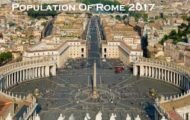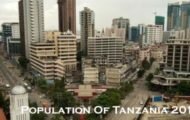Russia, is a federal state in Eurasia. With a total area of 17,075,200 square kilometres (6,592,800 sq mi), Russia is the largest country in the world, covering more than one eighth of Earth’s inhabited land area, and then the ninth most populous, with over 146.6 million people at the end of March 2016.

Russia spans eleven time zones and incorporates a wide range of environments and landforms. Following the Russian Revolution, the Russian Federation, then became world’s first constitutionally socialist state. Russia was the first country to go Economic planning, during the acute period of global depression, Russia was the only Nation to survive through it because of its strongly developed economic structure.
The Russian economy ranks as the twelfth largest by nominal GDP and sixth largest by purchasing power parity in 2015.Russia has an extensive mineral and energy resources which makes it the largest with such reserves in the world, this also makes it one of the leading producers of oil and natural gas globally. The country is one of the five recognized nuclear weapons states and possesses the largest supply of these weapons of mass destruction. Russia is also a permanent member of the United Nations Security Council, as well as a member of the G20, the Council of Europe, the Asia-Pacific Economic Cooperation (APEC), The World Trade Organization (WTO).
POPULATION OF RUSSIA IN 2017:
Talking about population, in order to check out the population of Russia in 2017, we need to have a look at the population of the past 5 years. They are as per the following:
- 2012 – 143.2 million
- 2013 – 143.5 million
- 2014 – 145.3 million
- 2015 – 146.5 million
- 2016 – 146.6 million
RUSSIA Population 2017 – 146.9 million(Estimated)
After the fall of The soviet union, Russia’s population declined gradually but this fall in population slowed and stabilized in later years and took a steep increase after 2011. Russia is the ninth largest country in the world, and the largest country in Europe, by population. Because Russia is in both Europe and Asia, it is also ranked as the sixth largest country in Asia. The estimated population of Russia in 2017 is 146 million.
There are no official figures for the population of Russia in 2016, but the 2010 census, the results of which were released in late 2011 and early 2012, reports that the official population of Russia was 142.9 million. The most current estimate for 2016 reports that the population is around 143.4 million.
Russia is one of the few countries with a negative growth rate, and its 2016 population is a decline from an estimated population of 146.3 million in 2015. It’s currently the 9th most populous country on earth, despite being the largest by area.
A survey conducted in 2014 showed that Russia’s run of increasing births and decreasing deaths may be ending. From January to March 2013, the number of births shrank by about 4,000, while the number of deaths increased the same amount. This means the natural loss of population was about 20% larger than in the previous year. Russia’s natural change in population over the past twenty-five years has been fairly unstable, decreasing in the early 90s, leveling out and then climbing beginning in 2005 before leveling out again. The population of Russia is 144,221,341 excluding Crimea, whose annexation is not recognized by the majority of the global community.
DEMOGRAPHY OF RUSSIA:
According to the 2010 census, ethnic Russian people make up 81% of the total population with Six other ethnicities have a population exceeding 1 million – Tatars (3.9%), Ukrainians (1.4%), Bashkir (1.1%), Chuvash (1%), Chechens (1%) and Armenians (0.9%). In total, 160 different ethnic groups live within the Russian Federation’s borders.
Russia’s population density is 8.4 people per square kilometre (22 per square mile), making it one of the most sparsely populated countries in the world.
Here are a few statistics regarding the demography of the region-
Age structure
0-14 years: 16.94%
15-24 years: 9.71%
25-54 years: 45.16%
55-64 years: 14.27%
65 years and over: 13.92%
Median age total: 39.3 years
Birth rate 11.3 births/1,000 population
Death rate 13.6 deaths/1,000 population
Life expectancy at birth total population: 70.8 years
Languages Russian (official) 85.7%, Tatar 3.2%, Chechen 1%, other 10.1%
POPULATION DENSITY AND GROWTH RATE IN RUSSIA:
According to a survey by World Bank in 2014, Population density (people per sq. km) in Russia was last measured at 8.78.
While a part of the Soviet Union, Russia’s population grew steadily, from 98 million at the end of the Second World War to 148.5 million in 1991, just before the collapse of the Soviet Union. For the next 20 years, the population of Russia declined steadily. From its 1992 peak of 148,538,000, the number of people living in Russia fell to a low of just 143,201,700 in 2012.
The main cause of this fall in population was the shock and economic uncertainty of the transition from communism to capitalism.
.
But now the increased stability of recent years population decline in Russia gradually slowed and, in 2012, Russia saw its first population increase in two decades. Since then, Russia’s population has been steadily, if very very modestly, growing
The incorporation of Crimea, annexed from Ukraine in 2014, boosted Russia’s population by a further 2.2 million people.
FACTS ABOUT RUSSIA:
1. The Trans-Siberian Railway in Russia is the single longest railway in the world. It spans almost all the way across the county with a 9200 kilometer (or 5700 mile) stretch, railway departs in Moscow (located in European Russia) and crosses into Asia.
2. The country is home to the largest McDonalds restaurant in the world. With 700 seats.
3. Russians drive on the right-hand side of the road.
4. Lake Baikal in Russia is the largest freshwater lake in the world. It reaches 1642 metres (5,387 feet) in depth and contains around 20% of the world’s unfrozen fresh water.
5. Russia’s Volga River is the longest in Europe, with a length of around 3690 kilometres (2293 miles).Russia has the world’s largest area of forests.
6. Russia’s capital boasts more billionaire residents than any other city in the world.



